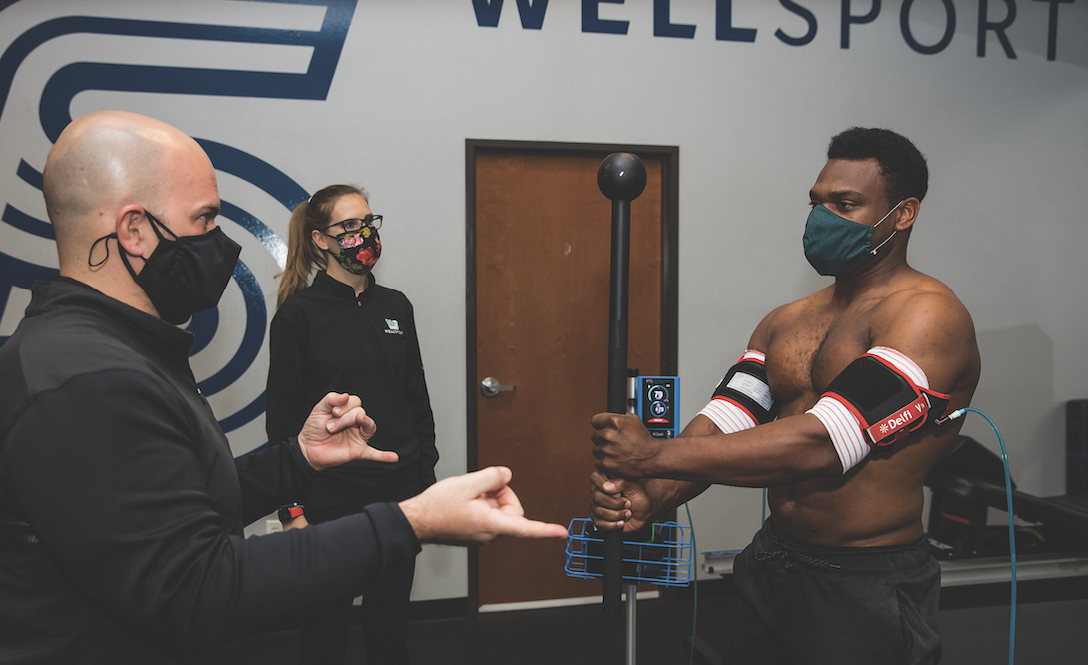Want the Muscles Without the Strain? Try Blood Flow Restriction Therapy

Let’s face it — aging can be no fun. Aching joints and longer injury recovery time are just two symptoms of aging that can make it harder to stay physically active. The gym can seem like a scary place when you are more prone to injury, but you shouldn’t ditch working out all together.
Would you believe it if you heard that you could build muscle without lifting a single weight? Well, it’s true. It’s not as easy as it sounds, but there is an unconventional way for you to get your pump in.
Everyone has been to the doctor and had their blood pressure taken. They wrap a band around your arm and pump it up until your arm feels like it might fall off. Well, these blood pressure bands have another use. Blood flow restriction therapy, or BFR, is a physical therapy method in which blood flow is restricted to the muscle. The aim of this is to use the pressure to prevent blood from leaving the muscle, while allowing more blood to go into the muscle.
This type of restriction creates a hypoxic environment, which occurs when the tissue lacks oxygen. The sensation that follows when you move your restricted body part can feel like a strenuous workout even though you’re not actually putting strain on your muscles. Studies have shown that a hypoxic environment has the ability to accelerate the process of muscle growth and performance.
WellSport, a facility in Austin, focuses on rehabilitation and allowing their clients to get back to their peak physical performance abilities. Its approach utilizes blood flow restriction therapy and has seen much success.
Kyler Brown, D.C., who specializes in pre- and post-surgical protocols at WellSport, says that BFR therapy can be beneficial for clients from older age groups.
“BFR helps to maintain muscle mass, which not only prevents injury, but helps prevent fall risks for elderly people, as well as maintaining health of ligaments, tendons and bones via collagen synthesis,” Brown says.
Although this kind of therapy has not yet been proven to prevent joint pain altogether, some clients at WellSport have reported lessened joint pain after their sessions.
Brown says this may be due to the fact that BFR puts a significantly lower amount of stress on the body than traditional weight lifting. Therefore, if clients switch from strenuous weight lifting to BFR training, it may result in less pain in the joints.

Can BFR stimulate the same muscle response as traditional weight lifting? Studies have shown that individuals who want to gain muscle need to be using weights heavier than 65% of their one rep max for a particular exercise. However, with BFR training, that number drops down to only 20-30%.
Blood flow restriction therapy is a great option for many people. BFR can help injured athletes get back on their feet quicker while staying in shape, people with fractures and bone injuries and older individuals who have more trouble with traditional weight lifting. However, every good thing has its limitations.
Declan Geraghty is a doctor of physical therapy who specializes in post-surgical physical therapy. When asked about the effectiveness of BFR and traditional weight lifting, he explains that they are equally effective in increasing muscle hypertrophy, but in other areas, weight lifting may be more beneficial.
“What BFR will not do is train someone to be coordinated, have skill acquisition or coordinated movements like performance training or weight lifting will provide,” Geraghty says.
Although BFR training is great for keeping someone in shape and their body strong, it can’t help with the development of new skills. For example, if a gymnast solely did BFR training, they would not have the balance, coordination or skill that comes with training for that specific sport.
It is also important to consider the risk factors of this kind of therapy. If done incorrectly, BFR can have serious consequences.
A study done by NCBI has shown that there is a negative link between BFR therapy and cardiovascular health. When comparing BFR training to weight lifting or aerobic exercises, there is a significantly greater increase in blood pressure and heart rate even during a low-intensity workout.
It is important to consider your current state of health before proceeding with BFR training. If you have a compromised heart or high blood pressure, BFR may be hazardous.
With more BFR band manufacturers coming out with products, they are not all as effective or safe. The biggest factors that contribute to this are improper tourniquet width, too much tourniquet pressure and improper placement of the tourniquet, which can all cause damage to the body’s soft tissue.
“What a lot of people need to understand, just like with any device or modality — it’s how you use it,” Geraghty says. “Making sure you use one of the FDA-approved devices with the guidance of a healthcare practitioner is crucial to rule out risk factors as well as make sure it’s used responsibly.”
When done correctly, one can see amazing results. Former University of Texas Longhorn and current NFL quarterback Colt McCoy has tried blood flow restriction therapy and has had great success with it.
“My work with WellSport and their use of BFR played an integral part in getting me beyond my injuries and allowed me to bridge the gap from rehab to training for an NFL season,” McCoy says.
If weightlifting is just not for you, or you need a safer way to stay in shape, try BFR therapy. As long as you do your research and ensure that your healthcare provider is trained, BFR can help you live a long, healthy life, especially as you grow older.






